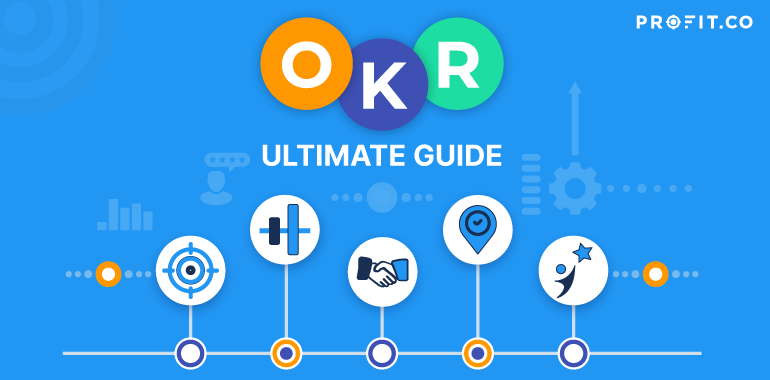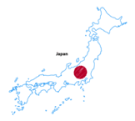|
Getting your Trinity Audio player ready...
|
OKR Meaning:
So, what is OKR?
In simple terms the acronym stands for “Objectives and Key Results”. In more detail, an OKR can be defined as a rigorous goal setting and tracking method invented by Andrew Grove and used in Intel from its early years. Andrew Grove derived the concept of OKR from the teachings of Peter Drucker’s Management by Objectives. People also know him as the father of OKR methodology.
The main idea of Andrew Grove’s OKR is defined by John Doerr as follows.
“The Key Results have to be measurable. But at the end you can look, and without any arguments: Did I do that or did I not do it? Yes or No? Simple. No judgements in it.”
Table of Contents:
-
OKR Definition
-
OKR Framework
-
A brief history of OKRs
-
Companies that use okrs
-
OKRs Comparison with other Goal Management Systems
-
Why are OKRs important for Business?
-
5 key benefits of OKRs
-
OKR levels
-
How to write great OKRs?
-
OKR examples
-
How do you implement OKRs?
-
OKRs – Frequently asked questions.
OKR Definition
As a whole, OKRs are meaningfully framed Objectives and Key Results which are designed and tracked to improve business performance. The definition of OKR is to set objectives for the future and measure those objectives with Key Results.
The OKR acronym stands for Objectives and Key Results. Objectives can be the broad goals of a company, department or a person. Key Results is the success measurement of that objective.
OKR Framework
The OKR (Objectives and Key Results) framework is a goal-setting methodology that promotes alignment and progress tracking.
It comprises three key components
- Objectives set qualitative, inspiring goals that guide efforts.
- Key Results quantify progress, providing measurable outcomes to gauge success.
- Initiatives outline actionable steps and projects to achieve the Objectives and Key Results.
The OKR framework fosters an agile and adaptable approach, enabling organizations to cascade goals from top-level to individual objectives. Regular check-ins and transparency ensure accountability and continuous improvement. By implementing the OKR framework, organizations cultivate focus, collaboration, and measurable outcomes for success.
Let’s take a closer look to answer the question: what are OKRs?
OKR is a goal management system used by teams, large and small, to collaborate and achieve stretch goals through a framework that requires regular check-ins, feedback, continuous learning, collaboration and problem-solving.
OKRs are simple yet powerful as they are useful for startups and large corporations to execute their strategy with focus and alignment.
Objectives (the O in OKR) are qualitative, inspirational, time-bound (typically in a quarter) goals to be executed by a team (say, Recruitment) or an individual.
Let’s look at a great OKR example, beginning with a quality objective:
- Build a high-performance analytics team.
This makes for a good OKR objective because there is a clear goal that teams can strive towards.
Key Results (KR), on the other hand, quantify the OKR’s objective and break it down to specific metrics that can be used to measure the achievement of the Objectives.
Vision without action is a daydream. Action without vision is a nightmare.
The above Objective can be broken down into Key Results like this:
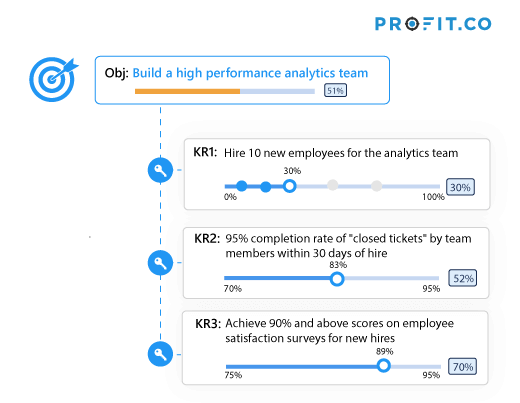
Watch our one minute video to explore what is OKR? ….
A brief history of OKRs.
Where do OKRs come from?
Andy Grove, the legendary CEO of Intel, is credited with introducing the concept of OKRs in the 1970s.
Intel encountered several large competitors like Motorola as they pivoted from being a memory vendor to a microprocessor vendor. The company had to battle against larger rivals in a highly competitive market.
Objectives and key results provided an excellent framework for Andy Grove to communicate his goals to the teams across the world. Teams agreed on stretch targets and executed them with great focus and alignment. Andy Grove reviewed progress every week, and early feedback helped teams on quick course corrections. The results were spectacular.
Intel beat every other competitor to become the world’s leading CPU vendor and, along with Microsoft, has been dominating the IT industry through the Wintel duopoly. John Doerr worked directly with Andy Grove at Intel and became a great believer in OKRs. He moved on from Intel and became a prominent Venture Capitalist with his investments and mentorship to companies like Google, Intuit, Amazon, Square, Uber, and Zynga.
In 1999 he introduced OKRs to Google when they were just 60 employees. Google has publicly credited OKRs for their phenomenal success. From Google, OKRs spread like wildfire across companies in Silicon Valley and beyond.
Companies that use OKRs
Today we see OKRs being adopted in companies across other verticals such as Banking, Media, Telecom, Insurance, and even the Public Sector.
Interest in OKRs has been surging in the 2010s
As you can see from the Google Trends curve depicted below — the interest in OKRS has been steadily increasing from 2012, and it surged after 2018 when John Doerr published his best-seller “Measure What Matters.” The book helped make OKRs go mainstream, and its popularity has steadily grown outside the tech industry.
Google Trends – OKRs (In US)
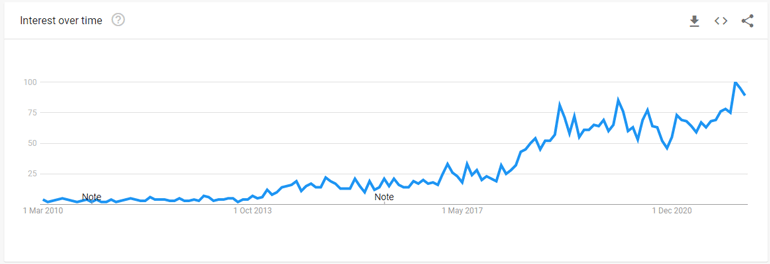
Marc Andreesen declared that software is eating the world, in his landmark 2011 Editorial in the Wall Street Journal. He describes that “Silicon Valley-style technology companies” will be taking over large swathes of the economy. He was citing companies like Apple, Amazon, Netflix, and LinkedIn completely disrupting large industries like Entertainment, Communication, Advertising, and Recruiting.
In May 2023 (at the time of this writing), the takeover of the “large swathes of the economy“ by Tech companies was realized.
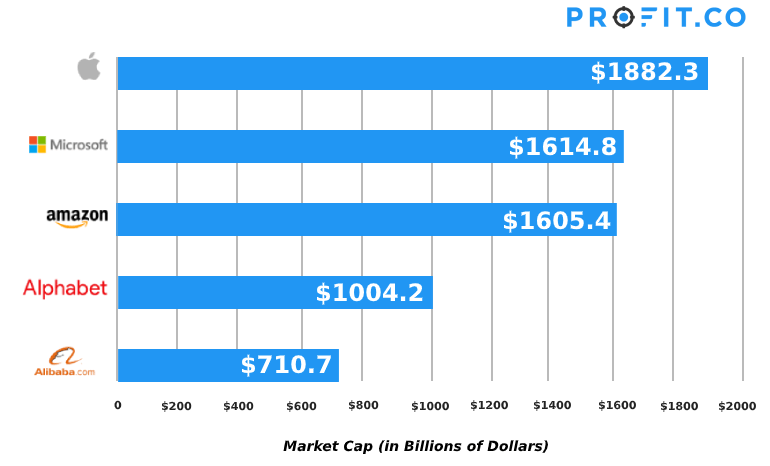
The top 4 companies here and almost all the companies referred to by Marc Andreessen have one thing in common: they have been operating with OKRs as their goal management system.
In addition to this, we see several other tech companies like Linkedin, Zynga, Spotify, and Netflix that also dominate their industry using objectives and key results.
As Steve Jobs said about the success of Apple products, the reason OKRs have been gaining widespread adoption compared to the hundreds of other competing Management Theories is simply because “it works.”
What is the best way to manage OKRs? Using an agile and intuitive software that can teach you: what are OKRs, how you can implement OKRs, and how you can continually improve. Profit.co is a versatile OKR management software that can be tailored to the exact needs of your business– you can
try this powerful OKR software free for 30 days.
OKRs Comparison with other Goal Management Systems
OKR vs BHAG (Big Hairy Audacious Goal)
| BHAG | OKR | |
|---|---|---|
| Name | Big Hairy Audacious Goal | Objectives and Key Results |
| Proposed by | Jim Collins in his classic book – ‘Good to Great” | Andy Grove Practiced OKRs first in Intel in the 1970s, Introduced to Google by John Doerr in 1999 |
| Definition | A BHAG is a huge and daunting goal, that is clear, compelling, capture’s people’s imagination and brings teams together to strive towards the finish line. | Objectives are inspirational, directional and qualitative statements, describing the goals to be achieved. Key Results are a set of metrics that help to measure and benchmark the progress towards the objective. |
| Example | The most iconic example is President John F Kennedy’s 1961 declaration that “America should by the end of the decade, land a man on moon and bring him safely back to earth” | Obj: Improve Product Stability KR1: Ensure all APIs respond within 100 ms KR2: No Severity 1 bug in Production system KR3: Achieve Average Page Load time of 3 seconds |
| Purpose | Communicating clearly ONE audacious goal and laying out the long-term mission | OKRs (Objectives and Key Results) help individuals, teams and companies to achieve stretch goals through a well-defined framework . The framework helps companies to achieve their strategic vision through OKR cycles. |
| Timeframe | Long term – will probably be longer than several OKR cycles. | Typically, one quarter, some-times can be 1 year |
| Availability of Implementation Framework | Does not provide any operational framework for realizing the lofty goal. | Detailed Framework for implementation available |
| Usage | Used by many startup founders, CEOS and political leaders to communicate their long-term vision | Most widely used goal management system by some of the most successful tech companies of our times and now spreading to other verticals as well. |
| Tools | Limited or no tools | Rich availability of software products for implementation |
OKR vs WIG (Wildly Important Goals)
| WIG | OKR | |
|---|---|---|
| Name | Wildly Important Goals | Objectives and Key Results |
| Proposed by | Stephen Covey, in his book “The 4 Disciplines of Execution” | Andy Grove Practiced OKRs first in Intel in the 1970s, Introduced to Google by John Doerr in 1999 |
| Definition | Wildly Important Goals are the most important goals that Can have an outsized impact on the performance of an Organization, Team or Individual. At each level it is recommended having not more than two WIGs | Objectives are inspirational, directional and qualitative statements, describing the goals to be achieved. Key Results are a set of metrics that help to measure and benchmark the progress towards the objective. |
| Example | Reduce Churn from 15% to 5% in 18 months | Obj: Improve Product Stability KR1: Ensure all APIs respond within 100 ms KR2: No Severity 1 bug in Production system KR3: Achieve Average Page Load time of 3 seconds |
| Purpose | To help Focus on the most important goals at all levels | OKRs (Objectives and Key Results) help individuals, teams and companies to achieve stretch goals through a well-defined framework . The framework helps companies to achieve their strategic vision through OKR cycles. |
| Timeframe | Depends on the goal and the specific circumstances. | Typically, one quarter, some-times can be 1 year |
| Availability of Implementation Framework | Has a high-level framework, but leaves out low-level Implementation details | Detailed Framework for implementation available |
| Usage | There is no specific sector that favors WIGs over other frameworks. | Most widely used goal management system by some of the most successful tech companies of our times and now spreading to other verticals as well. |
| Tools | Limited or no tools | Rich availability of software products for implementation |
Why are OKRs important for business?
Watch the latest podcast of our CEO, Bastin Gerald, a thought leader in the #OKR space, engaging in an enlightening discussion on OKRs.
Set goals with OKRs:
Companies run OKR programs as a workforce plan that helps them set goals and then align, prioritize, concentrate, and gauge the results of the work they perform to achieve those goals.
Implement your strategy with OKRs:
Companies make use of OKR programs to communicate the strategy in the most effective way possible. In addition, Companies make use of OKR programs to shift from the output based work culture to outcome-based work culture. A well implemented OKRs provide a transparent and objective performance appraisal mechanism enabling higher performance.
The 5 Key benefits of OKRs
According to John Doerr (the celebrated Venture Capitalist who popularized the OKR framework), there are 5 Key benefits of OKRs.

1. Focus: OKRs create focus on what matters.
Companies should define no more than 3-5 OKRs per team, department, or level, and less than 5 Key Results per Objective.
2. Alignment: OKRs align teams to a common goal
Research indicates that over 85% of corporate employees are unaware of organizational strategy and goals. OKRs solve this problem by ensuring that the Corporate goals (OKRs) are cascaded to department and team goals through top-down assignment or bottom-up alignment.
OKR Alignment gives clarity to employees about how their work contributes to the corporate goals and results in the entire organization executing in unison.
3. Commitment: OKRs engage and motivate employees
Commitments are OKRs that should be achieved without fail in the chosen time period.
(Example: 100% of employees to be given bias awareness training this quarter).
4. Tracking: OKRs enable measurement and tracking of key results
OKRs should be tracked every week. The metrics for the various Key Results are established at the beginning of the quarter and will be used for monitoring and tracking.
Teams will track their OKRs transparently using tools like Profit.co. It keeps everyone aware of the scoreboard and facilitates members helping those who need assistance in completing their commitments by sharing resources and expertise as required.
5. Stretching: OKRs drive and build a high-performance culture
OKRs should help the team elevate their performance beyond what they thought “was possible.” So the goals are ambitious, and a 70% achievement is considered “strong performance.”
An excellent way to encourage “Stretch Goals” within OKRs is to unlink the achievement of “stretch goals” from “compensation discussions” and instead make compensation decisions based on the effort put toward achieving OKRs.
OKR Levels
Aligning teams by setting OKRs based on organization structure.
In order to properly align OKRs in your organization and communicate your corporate strategy to each and every team member, you can set OKRs at different levels. Generally, there are four levels in each organization: the company level, the department level, the team level, and the individual level.
OKRs work at all levels of a business. At top level company-wide OKRs, department OKRs, and individual employee OKRs. The company-wide OKRs will become input for the team OKRs, which then will drive individual OKRs.
Some organizations choose to only use one or two OKR levels, while more complex enterprises might have to use all four in order to stay organized.
Company Wide OKRs:
OKRs at each level of the organization will look unique from one another. For example, an OKR at the corporate level will speak to high-level goals such as:
Objective: Become a market-leading business
Key Result 1: Grow our revenue
Key Result 2: Delight our customers with our support
Key Result 3: Launch our software 2.0 to improve UX and versatility
Key Result 4: Build a high-quality inbound lead pipeline
Team/Department OKRs: These high-level goals can then be broken down and assigned to departments. For example, the fourth key result to build a solid lead generation engine might then appear as a department-level objective for the marketing department:
Objective: Build a high-quality inbound lead pipeline
Key Result 1: Acquire at least 500 leads per week
Key Result 2: Maintain lead quality above 50%
Key Result 3: Produce and rollout amazing content
Key Result 4: Increase # of sessions per week to 2500
Key Result 5: Increase CTR for email to 15%
Furthermore, the third key result for this marketing key result could be cascaded as an objective for the Content team, a subsection of the marketing department. This way, OKRs cascade through an organization from one level to another, driving the entire company forward with singular focus and proper alignment.
How to write great OKRs
So, when you write OKRs it is important to know that the goals that are set will be visible at a single place and can be accessed by teams with permission, hence you are held accountable for the OKR.
As a beginner, you may struggle to pen down your thoughts as clearly defined objectives and Key Results. In order to hone your writing skills on OKRs, you can check out our OKR eBooks available for free download. This will help you and your team start strong with OKRs so you can see better results, faster. But there is also an easier way to learn about OKRs– instead of reading, you can try your hand at writing OKRs yourself with the best in class OKR software or OKR tool which would guide you to frame brilliant OKRs with its automated goal-writing features.
Here are some useful tips: Before you start creating an OKR, first break down your OKRs into smaller tasks that can be attained with measurable portions. Limit your KRs to two sentences. If you’re having trouble keeping the text concise and/or simple, consult with writing tools like BestEssaysEducation, Grammarly, and Supreme Dissertations. They help with writing easy-to-understand and impactful goal statements and other OKR-related documentation to share with employees.
Orient your teams to set up weekly and monthly goals and track their progress for inevitable success. Unexpected things can happen at unexpected times, remember various undefeated companies have also been a beginner at some point in time, so being a beginner doesn’t mean that you are lagging behind. A great start with a great platform can always make you a whiz.
Tips to write Good OKRs
Objectives: OKR Objectives should be motivating, short, memorable statements. Every team member should be able to recall their Objectives from memory without referring to their app or system.
Objectives need to be energizing, not dull. Feel free to use whatever works in your organization and is in sync with your culture. We have seen words like “out of this world,” “kickass,” “wicked,” “groovy,” “sweet,” “fab,” and “super-duper” used to describe Objectives.
Here are a few OKRs set by some companies that we all know:
- YouTube — “Reach 1 billion hours of watch time per day (by 2016)“
- Google — “We should make the web as fast as flipping through a magazine.”
- MyFitnessPal — “Help more people around the world.”
- The Gates Foundation — “Global eradication of Malaria by 2040“.
Key Result writing tips:
- You should have less than 5 key results for every objective.
- Key Results are metrics that need to be achieved and hence need to have numbers or be quantifiable.
- Key Results are ‘Results” not “tasks.”
Here are a few examples of Key Results that a few companies have used for their Objectives:
- YouTube — “Grow kids’ engagement and gaming watch time (X watch hours per day)“
- Google — “Achieve 20 million weekly active users for Google Chrome by year-end.”
- MyFitnessPal — “Add 27 million new users in 2014“.
- The Gates Foundation — “Sustain current global progress to ensure the environment is conducive to eradication push“.
OKR examples by organizational function
Here are some practical real world examples based on the team function or the department.
Customer Success OKR example:
Building an effective, well defined OKR will not only help you stay focused on your target but also provides you the platform to delight your customers.
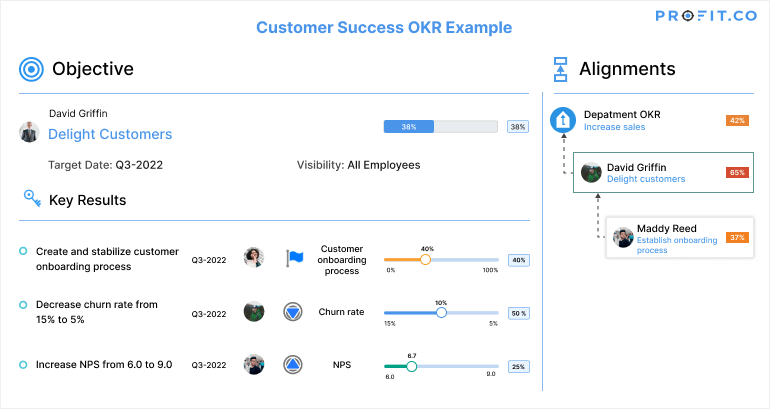
HR OKRs example:
Compensation and Benefits Team OKRs
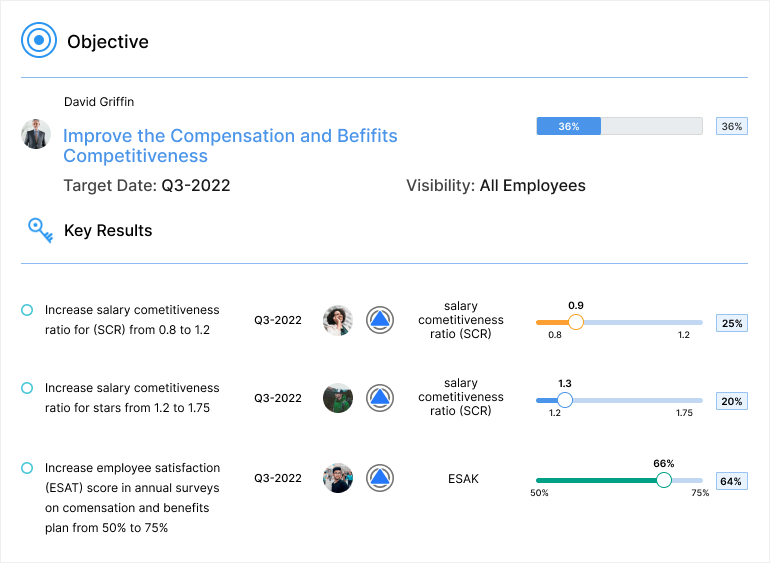
Finance OKR Example:
OKR example to improve their organization’s debt status.
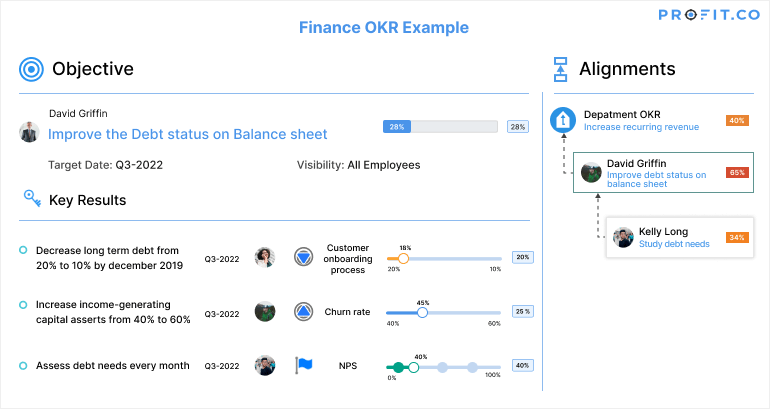
Engineering OKRs Example:
OKR example for improving the stability of product releases.
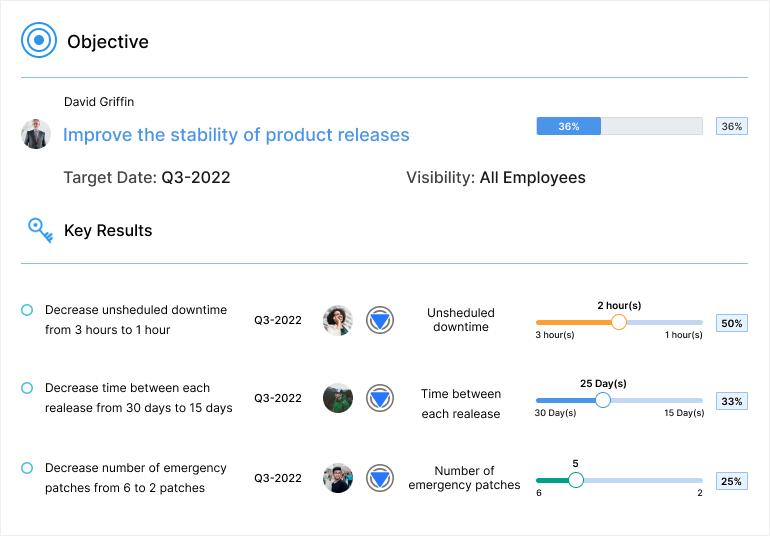
How do you implement your OKR program?
1. First Step is to Start.
By this time you must have Googled and learned about OKRs. Now ponder on the possibility of using OKRs in your business or organization, and find out how advantageous it would be to your company. The best way to get started with your OKR program is to stop planning and actually get started. You will have different combinations of culture, style, processes, and values that makes the DNA of every business or organization unique. There is a whole spectrum of possibilities on where and how to get started. The most important thing is to start, and adjust your OKR program along the way.
2. Set Company OKRs and Align your Team
Mostly, the personal goals and team goals are linked with the Objectives of the company to ensure that employees are aligned with the corporate priorities. Companies use OKR programs to make sure that the entire team and the organization are working towards the same Objective irrespective of employees having unique goals and targets.
3. Track, Measure and Iterate Regularly
Moreover, successful companies introduce OKRs and make it more like a habit. OKRs follow a quarterly pattern, and so they have to be changed or moved every quarter. As a standard best practice, many companies are particular about framing 3 to 5 Key Results for each Objective in order to make it attainable. They also make it a point to run OKR programs in an aggressive way such that it increases employee productivity, improves focus, and creates a better company culture.
An OKR implementation framework:
While learning new terminology and encouraging new habits within your company culture can seem daunting at first, you can implement your OKR program by following this seven steps framework.
- Familiarize yourself with OKR
- Get others to understand OKR
- Define/Refine your company’s vision
- Identify KPIs
- Create OKRs
- Evaluate
- Iterate
OKR – Frequently Asked Questions
Q1. Define OKR
The definition of “OKRs” is “Objectives and Key Results.” It is a business management methodology or tool used by teams and individuals to set challenging Objectives (O in acronym OKR) with measurable Key Results (KR in acronym OKR)
Q2. What does OKR stand for?
The OKR acronym stands for Objectives and Key Results.
Q3. What does OKR mean?
OKRs means Objectives (O in acronym OKRs) with measurable Key Results (KR in acronym OKRs)
Q4. What is the difference between KPI and OKR?
| KPI | OKR |
|---|---|
| KPIs are metrics to measure performance. | OKRs consist of Objectives and Key Results. |
| Acronym: KPI | Acronym: OKR |
| Key: Provides a means of achieving or understanding an intended Objective Performance: Defines a particular action, deed, or process Indicator: Designates the state or level of something |
Objectives: States what you want to accomplish |
| Key Performance Indicators (KPIs) are the critical (Key) Indicators of progress toward an intended objective, measuring an aspect of the objective of the business. KPIs quantify the objectives and break them down to specific metrics that can be used to measure the achievement of the Objectives. |
Key Results: These are measurable goals to be completed. |
Key Results can be associated with a KPI. The key is “can be”. Key Results do not necessarily have to be measured using a KPI, but these are helpful in quantifying progress.
Q5. What is OKR methodology?
The OKR methodology is a business management methodology or tool used by teams and individuals to set challenging Objectives (O in acronym OKR) with measurable Key Results (KR in acronym OKR)
Q6. How are Objectives and Key Results (OKRs) created?
Objectives and key results are created using a high-level, inspiring goal statement and measurable target outcomes. OKRs can be managed in an OKR tool or software and transparently tracked within an organization.
Q7. How to use OKRs to set company goals?
When a company has a long term strategy– such as a three-year, five-year, or even ten-year plan, they need shorter-term goals to ensure they meet their lofty aspirations. OKRs can help break down high-level strategy into goals that need to be completed within a quarter or a year. These can then be cascaded throughout the organization to ensure that all resources are dedicated to goals that matter to the company’s overarching strategy.
Q8. How often do you update OKRs?
OKRs are updated using check-ins. Check-ins can be completed at any frequency that works for your team. Usually, you’ll want to check-in key results on a weekly or bi-weekly basis to ensure that all updates are communicated to other team members and all learnings are recorded.
Q9. Should key results have dates?
Key results should always be time-bound to ensure that team members complete them promptly and within the proper time frame.
Q10. How many KRs should have an objective?
We recommend writing between 3 and 5 key results for each objective you set. Your KR list should be MECE’d– this means that the key results are all mutually exclusive and collectively exhaustive, so that each key result is tracking an important key indicator or process, and you’ll be able to tell if your objective is completely based on these key results.
Related Articles
-
15 Toughest questions on OKRs Answers by Ben Lamorte – Series 3
We recently hosted an insightful webinar with Ben Lamorte, a leader in OKR coaching. During the session, we covered everything... Read more
-
10 Toughest Questions on OKRs answers by Ben Lamorte -Series 1
In his Mastering OKRs Webinar, Ben Lamorte walks us through his 3-step Formula for successful OKR implementation. He tackles the... Read more
-
14 Toughest Questions on OKRs answers by Ben Lamorte -Series 2
Welcome back to Series 2 of "14 Toughest Questions on OKRs" with Ben Lamorte, where we address the most pressing... Read more
-
OKR Superpower: Aligning Product and Engineering for Maximum Impact
Product and engineering teams often face a tug-of-war between rapid feature delivery and technical feasibility. Product managers want to move... Read more
